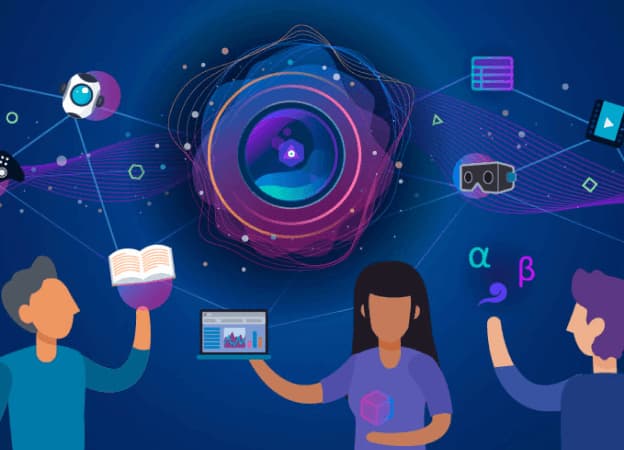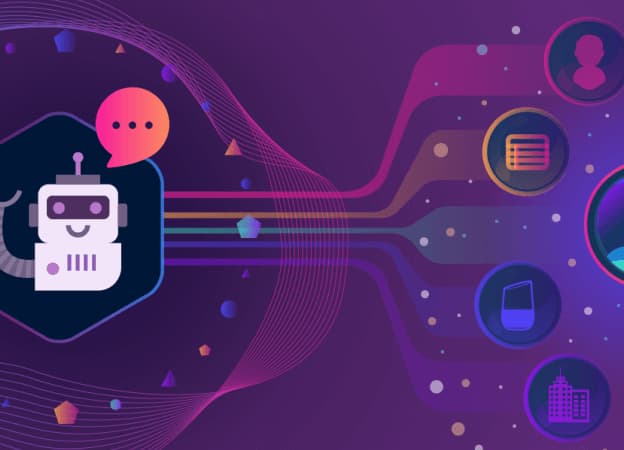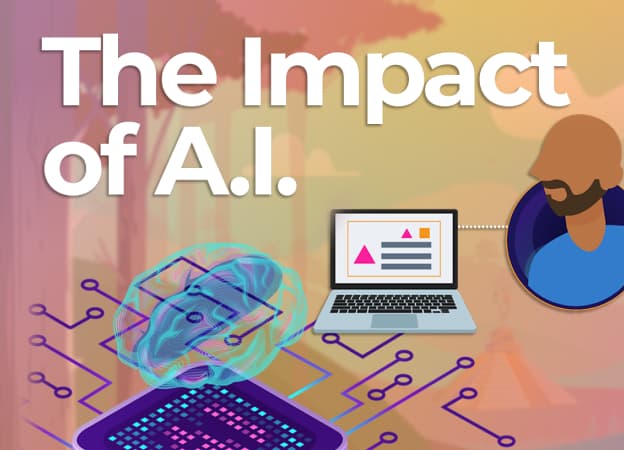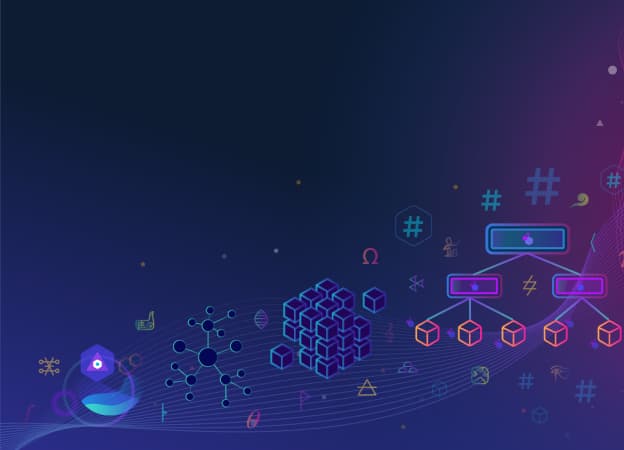Introduction
There is a recent renewal of interest in both Industry 4.0 and Information 4.0. Rapid advances in technology, propelled by Artificial Intelligence (AI) and Machine Learning, as well as strategic partnerships in manufacturing (e.g., BMW and Microsoft), are making tools for Industry 4.0 more scalable, affordable, and relevant.
Following popular blogs, memes, and press articles about AI and such, technical communicators could react with fear or complacency. At one extreme is the oft-cited scenario of robots replacing jobs, even those of documentation producers or lawyers. At the other extreme, we could lapse into the fantasy that some type of AI-driven assistant will do all the “nasty bits” of our jobs, and float us into a creative writer’s dreamscape.
Although content is already being created and consumed by machines, the constant need for an intelligent human factor ensures that our job prospects as techcomm professionals extend beyond the visible horizon. In reality, everybody in techcomm is in a very creative profession: we craft compelling communications for customer (human) experience. And part of our success is based on our individual experiences of human perception.
Our growing success in this sphere of the information-driven industry will erase the long-held perception that technical communicators are somehow “peripheral” to the product life cycle. As the true value of flexible and granular technical content becomes more evident, a golden age of technical communication lies before us. Reaching this promised land will, however, take an uncommon amount of collaboration and adaptation.
What Is Information 4.0 and Industry 4.0?
Industry 4.0 is a defined model for automating factories and data exchange that first emerged in Germany. The goal is the creation of factories that self-govern with hardware components (e.g., robots, assembly lines) that can essentially “self-heal” through context sensing.
Information 4.0 is the informational component for Industry 4.0. Though not yet precisely defined, Information 4.0 acts like an information exchange ecosystem that encompasses all aspects of Industry 4.0.
Most technical communicators are familiar with phases of the Industrial, Information, and Technical revolutions. There is a fourth revolution that is even more relevant to our practice than the Information Revolution; that is the Content Revolution. In this article, we explore the significance of the evolution of content and how it affects our ability to succeed with Information 4.0.
The Four Phases of Content Evolution
Many of us still practice a primarily page-based workflow with two or three publishing output channels. That page may be paper, PDF, or web. In the past dozen years, the proliferation of affordable WiFi and cellular connectivity has redefined mobile devices into a delivery channel that customers value as much as or more than print and PDF. We have no choice, our focus needs to expand.
In the diagram below, content visionary and [A] Master Architect Joe Gollner illustrates how the source and end-points of content flow have changed through the evolution of content.
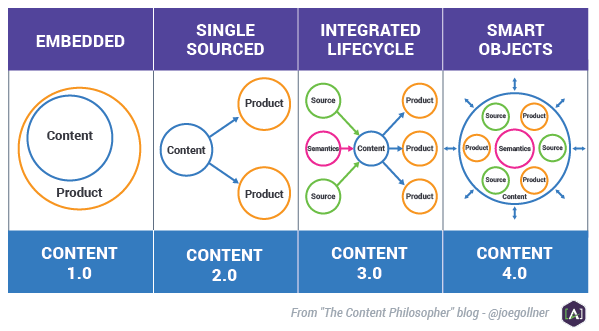
-
Content 1.0 - Content is created and managed as an integral part of the information product within which it is delivered to information consumers. Examples include a cave painting, a traditionally printed book, and most websites, including those offering measures of design responsiveness. Here, there is no separation between format and content.
-
Content 2.0 - Content within information products is isolated and managed separately from format and behaviour of individual information products. In this scenario, there is a need to produce multiple outputs from a single, shared source. Many technical communicators are still operating in this space, often referred to as “single-source publishing.”
-
Content 3.0 - Here, the goal becomes the management of content as an integrated library of assets where all details are managed at their most authoritative source. Content 3.0 can be referred to as Integrated Content. The focus is on leveraging the integrated nature of content to optimize how organizations operate and interact with their customers. This practice is steadily gaining momentum.
-
Content 4.0 - Content is planned, designed, created, managed, and exchanged as objects. These incorporate intellectual and rhetorical import, as well as the associated rules governing the structure and meaning of the content, and an array of rendering and behaviour processes. The content co-exists with the complete array of known behaviours it supports and it is exchanged with stakeholders who will publish and use the content and behaviour in their own environments and to meet their own goals.
Source and Deliverables with Content 4.0
Content 4.0 has demonstrated significant growth which parallels Information 4.0. In the diagram below, we can see how the focus of communicators is shifting from the publications themselves towards progressively smaller and smarter content components. At the most advanced stage, communicators divide their attention between very small units of content, which we came to refer to as "molecules", and the encapsulating content objects that combine these molecules into components and topics and match them to application behaviour, such as rendering instructions.
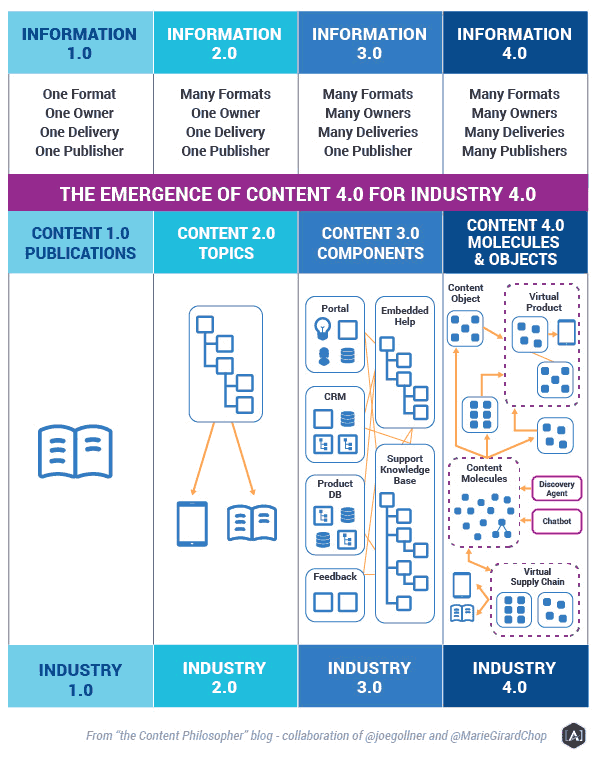
We can also see that as we move towards Content 4.0, there is a greater and greater awareness of and interaction with various applications that govern either the source or destination for publications.
How Does Content 4.0 and Information 4.0 Impact Technical Communicators?
Information 4.0 for Industry 4.0 demands Content 4.0. And, Information 4.0 demands that technical communicators work on Content 4.0. This leads to significant trends that we cannot escape: content must become even more technical and precise and at the same time become much more collaborative. Content creation becomes just one part of a total system, not an end-product unto itself.
Priorities for technical communicators will change in profound ways: Product and process design documentation must become more sophisticated and also more machine-readable. Machine consumption encompasses chatbots, physical robots, augmented reality interfaces, AI agents, and a host of other instances.
Finally, team collaboration takes center stage as the content must be more consumable on the human side. This means that technical communications professionals will become even more strategic and become perceived by budget stakeholders as the critical asset they always have been.
Is Managing an Increased Information Flow a Daunting Task?
Yes. There is no doubt that increases in content volume and flow will strain existing systems. But there is good news! There are standards, tools, and practices that have evolved over decades to support the demands on content to do more. DITA stands out as one significantly tested standard for content structure and multichannel publishing. Many existing semantic standards exist within industry verticals, such as healthcare and manufacturing. And, some engineering models and methodologies already exist that will help manage the resulting complexity. And, Artificial Intelligence (AI) has advanced to the point where it can assist in this transition. It can be applied to accelerate content processes, tagging, and metadata enrichment, and influence the reduction in handling costs and improve publishing scale.
None of that solves the problem. AI is simply not the solution for all dimensions of complex content scale challenges. DITA, or any standard, alone is not enough. Neither is it enough to implement a governance regime; or upgrade to a structured, component-based Content Management System and Digital Asset Management platform.
Standards help. Technology helps. Governance helps. Models and workflows help.
But, it is leadership and collaboration that makes the difference.
Collaborate for the Win: ISTC, the Information 4.0 Consortium, and the Content Order
Learning and collaboration across boundary-lines between disciplines become necessary. Much of the emerging information we need as technical communicators will come from our peers in other enterprises within our own and other industries. Arguably, the most relevant near-term discoveries will come from people like ourselves who have daily hands-on with content production. We cannot rely just on thought leaders.
We all need to collaborate and learn together. Let’s examine three organizations where we can expand our expertise and relevant skills as the evolution of content continues full-steam ahead.
Institute of Scientific and Technical Communicators (ISTC)
An obvious site for online networking and face-to-face learning is the annual ISTC-sponsored TCUK 2019 conference to be held Sept. 10-12, 2019 in Warwickshire. Since 1972, the Institute of Scientific and Technical Communicators (ISTC) has been “the home of technical communication excellence in the UK.” The publication you hold in your hands, ISTC Communicator, is a quarterly compendium of critical information on the most relevant skills and trends you need to track. Primary benefits of membership include encouraging professional development, sharing best practices and standards, and providing research resources.
The Content Order
Created in 2019, the Content Order is a nascent membership program hosted by [A] for anyone invested in the future of content. (Disclaimer: I work at [A] as the Executive Producer for the Content Technology Landscape. As enterprise content publishers approach the year 2020, we need to overhaul our content ecosystems, including massive changes across people, process, and technology. This new order of content intelligence has been driven by educated leaders working hard to achieve an entirely new way of working with content, enterprise knowledge, and customer experiences ... a new “order” to content. Membership in the Content Order is free to industry participants. Benefits of joining the Content Order include a Content Intelligence Treasury periodical; a compendium of online resources and emerging insights into intelligence transformation; access to educational assets and research reports; and members-only roundtable discussions and facilitated sharing of peer ideas and best practices, providing a way for us to all get smarter, together.
Conclusion
As technical communicators, we need to rethink how we plan, design, create, manage, and modify content assets and how we publish and exchange the resulting information products. Our take-away actions from this article are get educated, get involved, adapt, and collaborate.
How can we best collaborate? With peer-facilitated sharing of pure ideas, best practices, and productive roundtable discussions. This interaction can be in dynamic, real-time communication, and through a growing treasury of online knowledge that we build together.
On the Information 4.0 Consortium website, we find a very “muscular” quote from American thought leader Andrea Ames: “Drive the bus or get hit by it.” Well, that is quite a departure from self-driving cars! But this advice works regardless of which side of the road we drive on!
